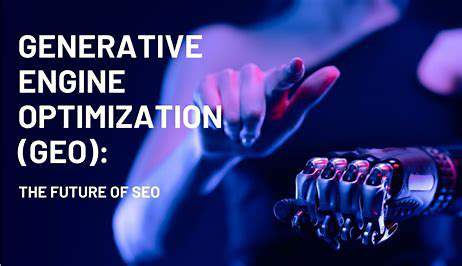Master Generative Engine Optimization: The Ultimate Guide to Ranking in AI Search Engines
The digital landscape is evolving rapidly, with AI-powered search engines like ChatGPT, Gemini, and Claude reshaping how users discover content. Traditional SEO is no longer enough. Unlock AI-driven visibility with proven Generative Engine Optimization (GEO) strategies. Learn how to rank in AI engines like ChatGPT and boost organic traffic. Ready to explore The Art of Ranking in AI Engines today? Let’s dive in.
ONLINE EARNING
4 min read
Introduction
The digital landscape is evolving rapidly, with AI-powered search engines like ChatGPT, Gemini, and Claude reshaping how users discover content. Traditional SEO is no longer enough—enter Generative Engine Optimization (GEO), the art of tailoring content for AI-driven platforms. Whether you’re a marketer, content creator, or business owner, understanding GEO is critical to staying visible in this new era.
In this comprehensive guide, we’ll explore how GEO works, why it matters, and actionable strategies to dominate AI rankings. Plus, don’t miss your chance to dive deeper with our ebook, The Art of Ranking in AI Engines—a must-read for mastering AI search algorithms.
What is Generative Engine Optimization (GEO)?
Generative Engine Optimization refers to techniques designed to improve content visibility in AI-generated responses. Unlike traditional SEO, which targets keyword-based searches, GEO focuses on aligning with AI models’ preferences for natural language, context, and user intent.
Why GEO Differs from Traditional SEO
Intent Over Keywords: AI engines prioritize solving user queries contextually.
Semantic Understanding: Content must address related concepts, not just exact keywords.
Dynamic Learning: AI models evolve continuously, requiring adaptive strategies.
For a step-by-step framework to implement GEO, check out The Art of Ranking in AI Engines.
Why Generative Engine Optimization Matters
The Rise of AI Search: Over 40% of users now rely on AI tools for information, bypassing traditional search engines.
Higher Engagement: Well-optimized GEO content earns featured spots in AI responses, driving organic traffic.
Competitive Edge: Early adopters of GEO dominate niche markets as AI adoption grows.
Global Impact of GEO
While GEO strategies apply universally, tailoring content for regional dialects, cultural nuances, and local trends can amplify reach. For instance, a GEO-optimized article targeting “sustainable fashion trends” should adapt terminology for audiences in Europe, Asia, or North America.
5 Proven GEO Strategies to Rank in AI Engines
1. Prioritize Natural Language & Context
AI models favor conversational content. Use FAQs, long-form explanations, and real-world examples. Avoid keyword stuffing—instead, integrate semantically related terms (e.g., “AI ranking tips” alongside “generative engine optimization”).
2. Structure for Featured Snippets
Break content into scannable sections with headers like “How to…” or “Why Does…”. Lists, tables, and bullet points increase chances of being featured in AI responses.
3. Leverage User Intent Analysis
Tools like AnswerThePublic or SEMrush’s Topic Research help identify questions your audience asks. Create content that addresses these queries comprehensively.
4. Optimize for Multimodal Content
AI engines analyze text, images, and videos. Add alt-text to images, transcribe videos, and use descriptive captions.
5. Build Authority with E-E-A-T
Google’s Expertise, Experience, Authoritativeness, and Trustworthiness framework applies to GEO. Cite credible sources, showcase credentials, and update content regularly.
Pro Tip: Dive into advanced tactics with The Art of Ranking in AI Engines, which includes case studies and templates.
Case Study: How GEO Doubled Organic Traffic for a Tech Blog
A SaaS company implemented GEO strategies by:
Rewriting blog posts in a conversational tone.
Adding “People Also Ask” sections.
Embedding video tutorials with transcripts.
Within three months, their content appeared in 60% more AI-generated answers, doubling website traffic.
Essential Tools for GEO Success
Surfer SEO: Analyzes top-ranking content for AI-friendly structures.
Clearscope: Recommends semantically related keywords.
ChatGPT Playground: Test how AI models interpret your content.
MarketMuse: Audits content for depth and relevance.
Your Ultimate GEO Resource
For a curated list of tools and step-by-step optimization workflows, The Art of Ranking in AI Engines offers exclusive insights.
The Future of GEO: Staying Ahead of AI Evolution
As AI models integrate real-time data and voice search, GEO will prioritize:
Personalization: Tailoring content to individual user histories.
Ethical AI Practices: Avoiding manipulative tactics as platforms penalize spam.
Global Adaptation: Localizing content for non-English markets.
Conclusion
Generative Engine Optimization isn’t just the future—it’s the present. By mastering GEO, you position your content at the forefront of AI-driven discovery. Ready to unlock proven strategies, case studies, and expert frameworks?
📘 Grab your copy of The Art of Ranking in AI Engines today and dominate AI search rankings!
Whether you’re optimizing a blog, e-commerce site, or SaaS platform, this guide is your roadmap to GEO success. Don’t get left behind—adapt, optimize, and rank!
Liked these tips? Click here to get The Art of Ranking in AI Engines and start your GEO journey now! Limited-time discounts available—act fast!
FAQs: Generative Engine Optimization (GEO) Explained
1. What’s the difference between SEO and GEO?
SEO focuses on optimizing content for traditional search engines like Google using keywords and backlinks. GEO, however, tailors content for AI models like ChatGPT by prioritizing natural language, user intent, and semantic context. While SEO is static, GEO adapts to evolving AI algorithms.
2. Why is GEO critical for AI-driven search engines?
AI tools like ChatGPT now power over 40% of online queries. GEO ensures your content is structured and contextualized to meet AI preferences, increasing visibility in AI-generated answers and driving organic traffic.
3. How do I measure GEO success?
Track metrics like AI-generated answer appearances (using tools like Ahrefs), organic traffic from AI platforms, and engagement rates. For detailed analytics frameworks, The Art of Ranking in AI Engines includes cheat sheets.
4. Can I use traditional SEO tools for GEO?
Yes, tools like Clearscope or Surfer SEO help identify semantic keywords. However, AI-specific tools like ChatGPT Playground are essential to test how models interpret your content.
5. Does GEO work for non-English content?
Absolutely! GEO thrives on localization. Adapt content to regional dialects, cultural references, and trending topics. For example, “sustainable fashion” in French (“mode durable”) requires unique GEO strategies.
6. How often should I update GEO-optimized content?
AI models update every 3–6 months. Audit content quarterly, refresh examples, and incorporate new user intent trends.
7. Is GEO only for written content?
No. AI engines analyze videos, images, and podcasts. Add transcripts, alt-text, and metadata to all content types.
8. What are common GEO mistakes to avoid?
Keyword stuffing instead of contextual writing.
Ignoring regional language nuances.
Failing to test content with AI tools.
Pro Tip: Avoid these pitfalls with actionable checklists from The Art of Ranking in AI Engines.
Connect with Us
Join our community for Health, Beauty, Online Earning, and Essential Tools!
Write to us
Get 24/7 Access to Wealth-Building Tools
Act Now! CLAIM Your E-BOOK TODAY
contact@dealconnect.store
Email:
© 2025. All rights reserved.


